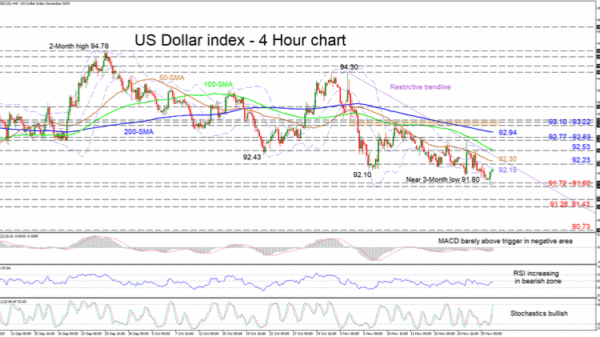The US Dollar index (December) is nearing the capping mid-Bollinger band at 92.15, after improving slightly from the support section of 91.72-91.80. Despite this recent price development, the bearish bias remains intact, something also being endorsed by the downward sloping simple moving averages (SMAs).
The short-term oscillators reflect the fresh increase in positive momentum. The MACD, in the negative region, has nudged above its red trigger line, while the RSI is rising towards its 50 threshold. The stochastic oscillator is positively charged – with its %K line hitting the 80 level – sponsoring additional strengthening of the index.
To the upside, immediate resistance may originate from the mid-Bollinger band at 92.15 and the neighbouring high of 92.23. Should the index steer higher, the 50-period SMA at 92.30 and the nearby restrictive trend line, drawn from the 94.30 peak, may impede the index from appreciating further. However, if price conquers these boundaries, it could face next resistance at the 92.53 high, where the 100-period SMA has currently merged with the upper Bollinger band. Conquering this reinforced point too, the index may jump towards another resistance band of 92.77-92.83 before advances become challenged by the 200-period SMA at 92.94.
If the bearish bearing resumes, first limitations to downside tendencies may come from the hardened support base of 91.72-91.80. Successfully diving below this critical border may trigger a drop towards the 91.43 and 91.26 lows, from April 2018. If these fail to halt the decline, the price may then target the 90.73 trough.
Summarizing, the US dollar index continues to convey a weakening trend below the SMAs in the short-term timeframe. A break below 91.72 may dampen the bias, while a shift above the buffer zone of 93.10-93.22, could inject some confidence in the dollar.














